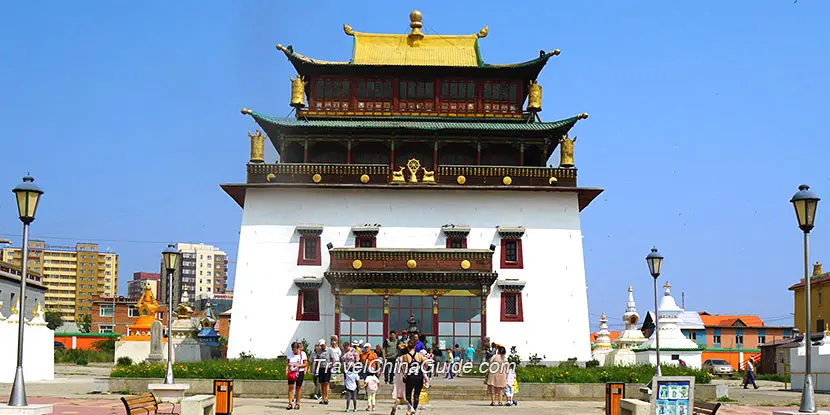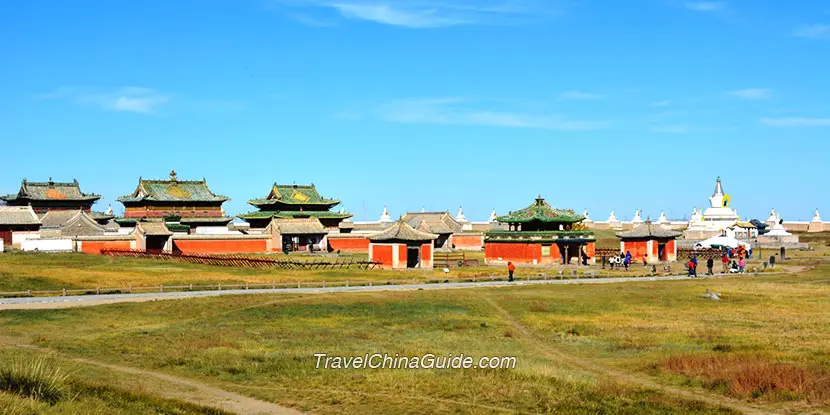Mongolia is the land of temples and treasures. It is one of the least industry affected destinations in the world and has a diverse collection of landscapes and living styles. For centuries, the country has attracted explorers from all across the globe. Right from the remote Altai Mountains of Western Mongolia to the deserts, it is going to be a memorable trip for your lifetime.
One of the key parts of the country's identity is its temples and monasteries.
Mongolians hold great respect for their culture and religious background, and for those who visiting the place can also experience a sense of spirituality all through the country.
You cannot miss the following most enigmatic temples in Mongolia in your next visit -
Most popularly referred to as 'gandan', this temple was built in 1838 and the name translates to 'a great place of complete joy'. During the time of its construction, it became Mongolia's main center for Buddhist education. It had nine colleges and more than 5,000 monks lived in this monastery. Unfortunately, the Stalinist purged most of its parts but was reopened in 1944 for international visitors. This was basically the only temple that functioned even during the communist regime. After 1990, it was restored as the Buddhist headquarter in the country.
Inside the main temple, there is a huge statue of Avalokitesvara which signifies bodhisattva. The one that is there today was built in 1966, symbolizing the nation's strength and rebirth from the Soviet rule. You will also find two other temples in the courtyard - the Ochidara Temple, which holds most important ceremonies and the Didan-Lavran temple, where the 13th Dalai Lama stayed in 1904.
 |
| Gandantegchinlen - Mongolia Temple |
This temple in Mongolia is called the 'monastery of tranquil felicity'. In fact, it is one of the three largest monastery centers in the country. China’s Manchu Emperor Yongzheng commissioned this structure and was created between 1727 and 1737. It marked the final resting place of Zanabazar who was the first spiritual leader of Buddhism in the country and also a very famous sculpture. Until 1936, the place housed more than 2,000 monks and included over 40 temples in the original courtyard. If you are visiting this place, you can see all the 28 of the original temple remains. In 1988, they were restored by UNESCO and are one of the most intact monasteries in Mongolia. What makes this different from the rest of the Mongolian monasteries is that it follows a Chinese style instead of the Tibetan temples. The symmetrical layout, various Chinese inscriptions, deep-red color scheme and the uses of Chinese roof guardian - this is an intricately decorated temple. Inside the main structure, you can see the Statue of Rinpoche Gurdava. Do not miss the morning ceremonies and the beautiful serene views surrounding the valley.
Compared to the earlier two, this temple in Mongolia not as impressive as you would think but it is one of the most prominent sites for the practicing Mongolian Buddhists. It was constructed in 1733 and dedicated to Manjusri - bodhisattva of wisdom. During its time, this was one of the largest monastic centers of the country and had more than 300 monks with over 20 temples. Again, during the Stalinist purge, the entire complex was demolished. But after the democratic revolution in 1990, the main temple was restored and serves as a museum today. Mandshir is one of the important parts of the Bogd Khan Nature Preserve and serves as one of the main terminal points of hiking.
This is one of the earliest surviving monasteries and you cannot miss this UNESCO listed temple in Mongolia. It means 'thousand Treasures' and was founded in 1586, which was the first Buddhist monastery of the country. During its peak time, it had more than 1000 monks staying here. The Stalinist purge destroyed all three of its temples and extensive restoration work during 1990 helped it become an active monastery and museum. This is one of the temples in Mongolia which was built with stones from Karakorum, an ancient city nearby. One hundred and eight stupas or shrines make a wall surrounding this temple. The monks perform a clockwise circumambulatory walk around the perimeter of these shrines. You can find an impressive collection of Buddhist statues in this place many of which as old as the 18th century.
 |
| Erdene Zuu Monastery, Mongolia |
Ongiin Khiid is a ruined temple in Mongolia but has been partially rebuilt now. Founded in 1760 to mark the first ever Dalai Lama's visit to Mongolia, it was one of the largest monasteries at that time. Comprising of two complexes, respectively on the North and South of the Ongi River, this temple was destroyed in 1939 under Khorloogiin Choibalsan. The tragedy killed more than 200 monks and many more were imprisoned or forced to join the army. Fortunately, a restoration work started some years ago, and the first temple was inaugurated in 2004. In fact, one of the stupas has been reconstructed and you can find a small museum with about 15 monks who serve as the guardians of the place.
This is one of the most beautifully decorated temples in Mongolia and is situated in the hills of the Khogno Khaan Natural Reserve. Zanabazar built this temple in the 17th century but Dzungarian chieftain Galdan Bolshigt destroyed it in a fight between the Eastern and the Western Mongolians. Even after the lower site was rebuilt, it was destroyed in 1930s. Post the democratic revolution in 1990, some temples were restored and the monastery was re-opened. Interestingly, it is today taken care by the granddaughter of the monks who originally lived here during the time of the persecution.

You May Like:
Mongolian Traditions with Religious Etiquette
6 Most Famous Mongolia Tourist AttractionsTop 3 Beautiful Mountains in Mongolia
- Last updated on Aug. 13, 2025 by Gabby Li -

